Air Force Vietnam War St. Charles, IL Flight date: 07/12/23
By David Adams, Honor Flight Chicago Veteran Interview Volunteer
Bastille Day, July 14, 1966, a day Duane Buttell, Jr. will remember forever! He was flying in the lead F-4 of four fighters tasked to provide MiG cover for three F-105s (“Thuds”) attacking surface to air missile (SAM) sites near Hanoi. His flight engaged two MiG 21 interceptors which threatened the Thuds. Duane’s F-4 fired three Aim-9 Sidewinder missiles at the first MiG, the third of which went up its tailpipe, detonated, and the MiG blew to pieces! His wingman shot down the other MiG 21 for good measure. “Splash” two enemy airplanes!
Born in Peoria, Duane grew up in Chillicothe, and attended Chillicothe Township High School graduating in 1959. He was active in sports and quarterbacked the football team which was inducted into the Greater Peoria Sports Hall of Fame in 2006. After graduation he made his way down to the University of Illinois at Champaign where he prioritized studying economics and acquainting himself with his future wife Judith, not in that order. While at the U of I he was a member of the Air Force ROTC. Destined for pilot training he completed the Flight Instruction Program earning his FAA private pilot certificate logging 36 ½ hours. He graduated as an AFROTC Distinguished Graduate and commander of his cadet wing. He was awarded a Bachelor of Arts with an economics major on January 24, 1964 a semester ahead of Judith.
Aa a freshly-minted 2nd Lieutenant, aka “Brown Bar”, he reported for Undergraduate Pilot Training (UPT) at Laughlin AFB, Del Rio, TX. He joined Class 65 XG which consisted of many students with significantly more flying time than he. Beginning UPT in April 1964 he mastered the rigorous academic curriculum, flight simulator training, and flying the T-37 “Tweet” and the T-33 Shooting Star. Upon graduation in February 1965 Duane next attended combat crew training in the F-4C at Davis-Monthan AFB, Tucson, AZ.
Completing the training in July he received an assignment to the 480th Tactical Fighter Squadron, the “Warhawks”, at Holloman AFB, NM to fly the F-4C. As a 1st Lieutenant pilot his F-4 duty position was as a pilot in the Phantom’s rear seat, affectionately known as the Guy in the Back, or GIB. He recalls that a GIB managed and deployed the wide array of weapons mounted on the F-4 and served as an indispensable crew member. Four eyes are better than two, especially in the heat of battle, he remarks. As his combat experience would demonstrate, his time as an F-4 GIB paid dividends when he became an Aircraft Commander himself and then an instructor pilot in three different fighters.
At the 480th TFS he met Captain William J. “Swede” Swendner, an Aircraft Commander, with whom he would be crewed for nearly two years. The squadron deployed to South Vietnam on February 1, 1966. Duane remembers that he and Swede were the lead F-4C in a flight of four ferrying their airplanes to their combat base somewhere in South Vietnam. Each four-ship flew with its own KC-135 tanker for air-to-air refueling between intermediate stops from Holloman to Vietnam. The squadron did not know at which base it would land to conduct combat operations until its last leg from Guam. It would be Da Nang AB.
Duane vividly recalls the final planned refueling during their first leg from Holloman to Hickam AFB, Hawaii. Each F-4 was “topped off” with fuel, that is all tanks should be full of JP4 before continuing on without tanker support. Swede bid the tanker farewell as it turned back east to rendezvous with another flight headed for Hawaii. Shortly after the tanker departed, Swede noticed that some of his fuel tanks were running dry and concluded that their F-4 would not reach Hawaii before it flamed out over the Pacific. He instructed the other three airplanes to continue to Hickam, turned back east, and contacted the tanker requesting it to rendezvous with him to refuel his F-4 and accompany it to Hawaii. Finally a pair again, the F-4 and KC-135 flew together to Hickam, problem solved.
Flying from Da Nang, the 480 TFS conducted combat operations over South Vietnam, Laos, and North Vietnam. Duane states that the squadron first flew sorties into South Vietnam and Laos for several months before venturing into North Vietnam. All told he completed 153 missions of which 100 were over North Vietnam. The latter sorties involved strike, or bombing, missions on assigned targets in the North Vietnam panhandle between the coastal mountain range and the South China Sea, and in the vicinity of Hanoi. His squadron also flew MiG Combat Air Patrol missions in support of F-105 Iron Hand suppression of SAM sites near Hanoi. These Iron Hand sorties attacking the North Vietnamese air defenses in advance of the fighter strike force were crucial.
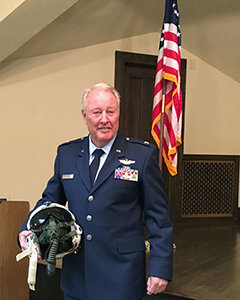
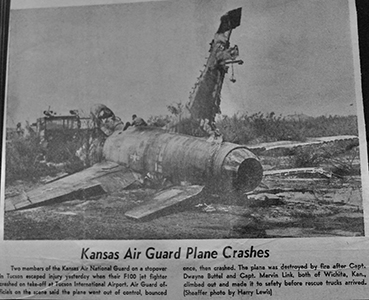
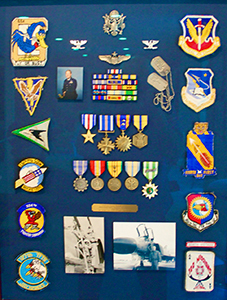
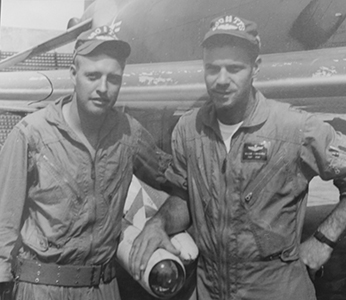
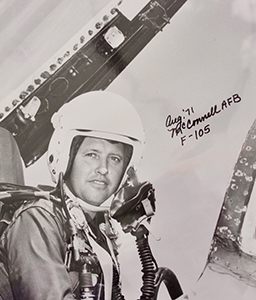
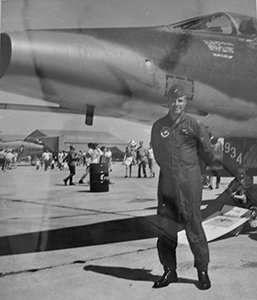
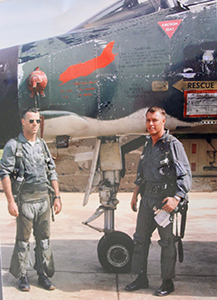
Duane recalls vividly the July 14, 1966 mission when his F-4 and wingman engaged MiG 21s over Phuc Yen, the major MiG 21 airfield, while protecting a flight of three F-105s. His Aircraft Commander’s official narrative of the dogfight tells it all accurately according to Duane. In Swede’s words:
“[The flight was escorting a fight of] three F-105 Wild Weasel Thuds (call sign “Panda”) out of Takhli. My flight was to provide MiG cover for the Thuds during an Iron Hand (SAM suppression) mission. I spotted the Thuds as we passed over the Black River headed for the south end of Thud Ridge. I had our standard escort combat load (for that time) of two wing tanks, a centerline tank, four AIM-7 Sparrow radar-guided missiles on the fuselage stations, and four AIM-9 Sidewinder heat-seeking missiles (two each on the inboard wing stations). . . . my number three man called “MiG, 8 o’clock high, coming in!” I looked over my left shoulder while turning hard left, and picked up the MiG as flashed behind the flight. I reversed hard right and jettisoned my wing tanks to “strip down” to fighting configuration.
“There was an extremely dense haze layer that reached right up to 7,000 feet, and I lost the MiG in that haze. I figured the MiG had dove for home when he missed his intercept and was no longer a threat. . . . [then] I also saw a MiG coming fast on Panda 3. . . . I informed my GIB (Guy In Back) Duane Buttell and called, “Panda 3, break right! MiG at 5 o’clock and closing!” He called back that he was locked on and about to launch a Shrike missile (missile which homed on radar emissions) at a SAM site. I replied “I’ll do what I can!” I continued to roll right, pulling my nose down on the MiG so that Duane could get a lock-on. He said “Locked up, cleared to fire!” I started to squeeze the trigger to launch a Sparrow, noticed the break X on the scope out of the corner of my eye and heard Duane say “Too close” … all within a few milliseconds.
“I selected HEAT, squeezed the trigger (again with a break X) and fired a Sidewinder, knowing that I was too close, with too much angle off. The missile went past the MiG’s canopy, but did not detonate because it had not had time to arm. But the MiG knew that someone was around. He lit his burner and broke up and to the right. He now had me “trapped” at his deep six . . . I let him extend, since he was straight out in a blue sky, which is a perfect background for the Sidewinder because there is no heat source other than the target for it to look at. I fired a second Sidewinder, which promptly blew up about 500 feet in front of me! I was really gnashing my teeth now, but told myself to settle down and track the bastard! I still had a good tone, so I fired a third Sidewinder, watched it wiggle around the way AIM-9s do when they are tracking. It appeared to pass him, and I said “Shit, Duane, we missed!” All of a sudden, there was a huge fireball and pieces of airplane all over the place! The missile must have gone right up the MiG’s tailpipe before detonating.”
Duane remembers that the F-4 flew through the MiG 21 debris field, but without significant damage. Upon returning to Da Nang their wingman confirmed they had shot down another MiG 21 with a Sidewinder. They all agree with Swede, “We had one hell of a party that night!!!”
The next day, July 17, Duane, Swede, and their wingman pilots, Lieutenants Martin and Krieps, were flown down to Saigon for another debriefing. Upon arrival there, Swede and Lt. Martin, the aircraft commanders, met with Walter Cronkite in one room and Duane and Krieps in another. Their debriefing with intelligence officers centered on tactics and MiG 21 performance, all in an effort to optimize future engagements with North Vietnamese fighters.
Duane completed his tour in Vietnam in September 1966 after spending nearly eight months “in country”. He reported to the 334th TFS at Seymour Johnson AFB, NC where he continued to fly the F-4C/D. In November 1967 he began upgrade training to become an F-4 Aircraft Commander at Davis-Monthan. Completing the course he was designated the Outstanding Aircraft Commander. He remained at DM as an instructor pilot and garnered the Outstanding Instructor Award. During this assignment he attended the three-month long Squadron Officers School at Maxwell AFB, AL. Duane left active duty from DM on December 4, 1969 as a regular officer with the rank of Captain. His active duty service spanned five years and eight months.
He next joined the 127th TFS of the Kansas Air National Guard at McConnell AFB, Wichita KS where he checked out in the F-100 and F-105 becoming an instructor in both. Duane also served as chief of academics. His checkout in the F-100 involved a single flight in the single seat version of the Super Sabre. Originally his instructor pilot/check airman intended Duane’s first flight, or “Dollar Ride”, to be in the two-seat version, the F-100F. Their assigned airplane was unavailable so Duane climbed into the F-100C for a very, very brief indoctrination. His instructor flew another F-100C and after some basic maneuvers and landings Duane was a newly-qualified F-100 pilot.
While with the 127th Duane and another instructor pilot flew one half of an eventful cross country from McConnell AFB to Tucson International, AZ. The outbound leg in the F-100F was routine. For the return trip Duane flew in the front seat. Takeoff roll was normal. But once the F-100 lifted off the runway things got very exciting. Before Duane could raise the landing gear the airplane rolled to the right. He saw that the right wing slats, designed to provide low speed control, had unexpectedly extended. The left wing slats remained retracted. This caused the F-100 to turn right. Duane applied full left rudder in an attempt to level the wings, which he did. Now just barely airborne off the right side of the runway, Duane put the airplane down in the desert. The gear sheared off. The airplane came to rest and started blazing. Both pilots got out rapidly and in one piece. Fire consumed the F-100. More than “just another day at the office”!
Duane retired from the Guard on October 14, 1975 with the rank of Major. His military career resumed when in 1981 he joined the 9001st Air Reserve Squadron as an Admissions Liaison Officer for the United States Air Force Academy. In that capacity his mission was to identify and recommend candidates for the USAFA which he did with distinction. He retired from the Air Force Reserve on April 1, 1993 having risen to the rank of Colonel (O-6) holding the senior pilot aeronautical rating. He logged more than 4,000 hours in high performance fighter aircraft. Duane flew and instructed in the F-100C Super Sabre, F-105D/F Thunderchief, and F-4C/D Phantom II.
His military decorations and awards include the Silver Star, awarded in recognition of his MiG 21 victory; Distinguished Flying Cross; Air Medal with 10 oak leaf clusters; Air Force Commendation Medal; Air Force Achievement Medal; Presidential Unit Citation with two oak leaf clusters; and Air Force Outstanding Unit Award with bronze “V” device, among many other medals and ribbons.
In 1972 while a member of the Guard he joined American Airlines. Starting as a Flight Engineer he advanced to Captain, Flight Supervisor, and Check Airman. During his career with American, he flew the Boeing 727, 707, 757, 767, 777, McDonnell Douglas MD 80 and DC 10, accumulating more than 20,000 flight hours. He served as a flight superintendent and check airman with American in the European, Pacific, Far East and South American divisions. He retired in April 2001
Duane has also been an active member of his St. Charles community serving as a board member for several community, school and church organizations.
He married Judith in 1964 during his Air Force UPT assignment in Texas. Judith and he recently celebrated 59 years of marriage. They have two children and five grandchildren.
Reflecting on his Vietnam service and return to the States in 1966, he does not remember a “welcome home, job well done” greeting. He is looking forward to a different greeting on his Day of Honor!
Thank you, Duane, for your dedication and distinguished service during challenging times. Enjoy your special day of honor in Washington D.C. with your comrades in arms! Expect a splendid welcome home.


